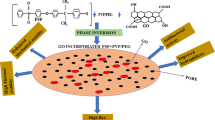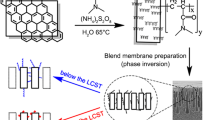Abstract
Techniques such as plasma treatment and electrophilic aromatic substitution are strategies commonly used to increase membrane hydrophilicity. We here suggest the addition of graphite (the contents of 0.5, 1.0, 2.0, 3.0, 4.0 and 5.0 mass%) in the system composed of polysulfone/N-methyl-2-pyrrolidone/water and, consequently, the formation of a composite membrane as a method to increase membrane hydrophilicity. Polysulfone-graphite membranes were prepared by wet-phase inversion method and were compared to that of pristine polysulfone membrane. From X-ray diffraction and Fourier transform infrared spectroscopy, it was observed that the structures of both starting materials were maintained. Scanning electron microscopy images revealed a cellular morphology of both membranes and the presence of graphite particles in the cross-sectional area. Contact angle measurements showed that Lewis acid-base interactions were favored by graphite addition and membrane hydrophilicity increased by increasing the graphite content except for the membrane prepared from a dispersion containing 3.0 mass% graphite. By increasing the graphite content, the onset temperature of degradation was increased and mass loss was decreased whereas only the membranes with low graphite content presented an increase in glass transition temperature. Finally, from tensile tests, it was noted that the presence of graphite particles resulted in the brittleness of the composite membranes.






Similar content being viewed by others
References
Strathmann H. Membrane separation processes. J Membr Sci. 1981;9:121–89.
Anadão P. Ciência e tecnologia de membranas. 1st ed. São Paulo: Artliber Editora; 2010.
Cieśla K, Rahier H, Zakrzewska-Trznadel G. Interaction of water with the regenerated cellulose membrane studied by DSC. J Therm Anal Calorim. 2004;77:279–93.
Loeb S, Sourirajan S. High-flow semipermeable membranes for separation of water from saline solutions. Adv Chem Ser. 1962;38:117–32.
Strathmann H. Development of new membranes. Desalination. 1980;35:39–58.
Pesek SC, Koros WJ. Aqueous quenched asymetric polysulfone membranes prepared by dry/wet phase separation. J Membr Sci. 1993;81:71–88.
Khansary MA, Marjani A, Shirazian S. On the search of rigorous thermo-kinetic model for wet phase inversion technique. J Membr Sci. 2017;538:18–33.
Durmaz EN, Çulfaz-Emecen PZ. Cellulose-based membranes via phase inversion using [EMIM]OAc-DMSO mixtures as solvent. Chem Eng Sci. 2018;178:93–103.
Bhran A, Shoaib A, Elsadeq D, El-gendi A, Abdallah H. Preparation of PVC/PVP composite polymer membranes via phase inversion process for water treatment purposes. Chin J Chem Eng. 2018;26:715–22.
Munirasu S, Banat F, Durrani AA, Haija MA. Intrinsically superhydrophobic PVDF membrane by phase inversion for membrane distillation. Desalination. 2017;417:77–86.
Garcia-Ivars J, Wang-Xu W, Iborra-Clar M-I. Application of post-consumer recycled high-impact polystyrene in the preparation of phase-inversion membranes for low-pressure membrane processes. Sep Purif Technol. 2017;175:340–51.
Altena FW, Smolders CA. Calculation of liquid-liquid phase separation in a ternary system of a polymer in a mixture of a solvent and a non-solvent. Macromolecules. 1982;15:1491–7.
Yip Y, McHugh AJ. Modeling and simulation of nonsolvent vapor-induced phase separation. J Membr Sci. 2006;271:163–76.
Asghar MR, Zhang Y, Wu A, Yan X, Shen S, Ke C, Zhang J. Preparation of microporous cellulose/poly(vinylidene fluoride-hexafluoropropylene) membrane for lithium ion batteries by phase inversion method. J Power Sources. 2018;379:197–205.
Anadão P, Wiebeck H. Membrane Preparation by Nonsolvent-Induced Phase Inversion: Polymers on. In: Mishra M, editors. Encyclopedia of Polymer Applications (EPA). New York: Taylor and Francis Group, in press.
Hang YS, Kim HJ, Kim UY. Asymmetric membrane formation via immersion precipitation method. I. Kinetic effect. J Membr Sci. 1991;60:219–32.
Barzin J, Sadatnia B. Correlation between macrovoid formation and the ternary phase diagram for polyethersulfone membranes prepared from two nearly similar solvents. J Membr Sci. 2008;325:92–7.
Mukherjee GS. Calorimetric characterization of membrane materials based on polyvinyl alcohol. J Therm Anal Calorim. 2009;96:21–5.
Leite AMD, Maia LF, Paz PA, Araújo EM, Lira HL. Thermal properties from membrane of polyamide 6/montmorillonite clay nanocomposites obtained by immersion precipitation method. J Therm Anal Calorim. 2009;97:577–80.
Vasile C, Costea C, Pascu MC, Warshawsky A. Thermoxidative decomposition of some polysulfones under dynamic conditions of heating. J Therm Anal Calorim. 1998;52:569–79.
Salvio Neto H, de Araujo GLB, dos Santos LL, Cosentino IC, Carvalho FMS, Matos JR. Inclusion of prednicarbate in the SBA-15 silica. J Therm Anal Calorim. 2016;123:2297–305.
Wang H, Wang W, Wang L, Zhao B, Zhang Z, Xia X, Yang H, Xue Y, Chang N. Enhancement of hydrophilicity and the resistance for irreversible fouling of polysulfone (PSF) membrane immobilized with graphene oxide (GO) through chloromethylated and quaternized reaction. Chem Eng J. 2018;334:2068–78.
Wavhal DS, Fisher ER. Modification of polysulfone ultrafiltration membranes by CO2 plasma treatment. Desalination. 2005;172:189–205.
Guan R, Zou H, Lu D, Gong C, Liu Y. Polyethersulfone sulfonated by chlorosulfonic acid and its membrane characteristics. Eur Polym J. 2005;41:1554–60.
Matsumoto Y, Sudoh M, Suzuki Y. Preparation of composite UF membranes of sulfonated polysulfone coated on ceramics. J Membr Sci. 1999;158:55–62.
Molnár G, Botvay A, Pöppl L, Torkos KI, Borossay J, Máték A, Török T. Thermal degradation of chemically modified polysulfones. Polym Degrad Stab. 2005;89:410–7.
Hajibeygi M, Maleki M, Shabanian M, Ducos F, Vahabi H. New polyvinyl chloride (PVC) nanocomposite consisting of aromatic polyamide and chitosan modified ZnO nanoparticles with enhanced thermal stability, low heat release rate and improved mechanical properties. Appl Surf Sci. 2018;439:1163–79.
Panda SR, De S. Preparation, characterization and performance of ZnCl2 incorporated polysulfone (PSF)/polyethylene glycol (PEG) blend low pressure nanofiltration membranes. Desalination. 2014;347:52–65.
Furuya K, Hafuka A, Kuroiwa M, Sato H, Watana Y, Yamamura H. Development of novel polysulfone membranes with embedded zirconium sulfate-surfactant micelle mesostructure for phosphate recovery from water through membrane filtration. Water Res. 2017;124:521–6.
Guillotin M, Lemoyne C, Noel C, Monnerie L. Physicochemical processes occurring during the formation of cellulose diacetate membranes. Research of criteria for optimizing membrane performance. IV. Cellulose diacetate-acetone-organic additive casting solutions. Desalination. 1977;21:165–81.
Xie P, de Lannoy C-F, Ma J, Wang Z, Wang S, Li J, Wiesner MR. Improved chlorine tolerance of a polyvinyl pyrrolidone-polysulfone membrane enabled by carboxylated carbon nanotubes. Water Res. 2016;104:497–506.
Bildyukevich AV, Plisko TV, Liubimova AS, Volkov VV, Usosky VV. Hydrophilization of polysulfone hollow fiber membranes via addition of polyvinylpyrrolidone to the bore fluid. J Membr Sci. 2017;524:537–49.
Kim SR, Lee KH, Jhon MS. The effect of ZnCl2 on the formation of polysulfone membrane. J Membr Sci. 1996;119:59–64.
Lin D-J, Chang C-L, Huang F-M, Cheng L-P. Effect of salt additive on the formation of microporous poly(vinylidene fluoride) membranes by phase inversion from LiClO4/Water/DMF/PVDF system. Polymer. 2003;44:413–22.
Yu Y, Yu L, Wang C, Chen JP. An innovative yttrium nanoparticles/PVA modified PSF membrane aiming at decontamination of arsenate. J Colloid Interface Sci., in press.
Anadão P, Sato LF, Wiebeck H, Diaz FRV. Montmorillonite as a component of polysulfone nanocomposite membranes. Appl Clay Sci. 2010;48:127–32.
Anadão P, Sato LF, Montes RR, De Santis HS. Polysulphone/montmorillonite nanocomposite membranes: effect of clay addition and polysulphone molecular weight on the membrane properties. J Membr Sci. 2014;455:187–99.
Anadão P, Montes RR, Larocca NM, Pessan LA. Influence of the clay content and the polysulfone molar mass on nanocomposite membrane properties. Appl Surf Sci. 2013;275:110–20.
Aerts P, Kuypers S, Genne I, Leysen R, Mewis J, Vankelecom IFJ, Jacobs PA. Polysulfone-ZrO2 surface interactions. The influence on formation, morphology and properties of Zirfon-membranes. J Phys Chem B. 2006;110:7425–30.
Ferrando F, Torras C, Garcia-Valls R, Paltakari J. Performance, morphology and tensile characterization of activated carbon composite membranes for the synthesis of enzyme membrane reactors. J Membr Sci. 2006;282:149–61.
Lu Y-H, Cao Y, Lu Y-W, Yang T. Thermal stability and lifetime of [AMIM]Cl-PFSA composite membranes. J Therm Anal Calorim. 2017;128:1601–15.
Ke H. Morphology and thermal performance of quaternary fatty acid eutectics/polyurethane/Ag form-stable phase change composite fibrous membranes. J Therm Anal Calorim. 2017;129:1533–45.
Fu S-H, Feng X-Q, Lauke B, Mai Y-M. Effects of particle size, particle/matrix interface adhesion and particle loading on mechanical properties of particulate-polymer composites. Compos B Eng. 2008;39:933–61.
Wen R, Jia P, Huang Z, Fang M, Liu Y, Wu X, Min X, Gao W. Thermal energy storage properties and thermal reliability of PEG/bone char composite as a form-stable phase change material. J Therm Anal Calorim. 2018;132:1753–61.
Sun Q, Yuan Y. Thermal properties of polyethylene glycol/carbon microsphere composite as a novel phase change material. J Therm Anal Calorim. 2017;130:1741–9.
Efe GC, Ozaydin F, Ucisik H, Bindal C, Liang H. Production of ultra-high molecular weight polyethylene-grafite composite films by gelation/crystallization. J Therm Anal Calorim. 2016;125:1659–65.
Petrini M, Ferrante M, Spoto G. Characterization of a bulk-fill resin-based composite by thermal analysis. J Therm Anal Calorim. 2016;123:2329–35.
Li M, Chen Y, Wu L, Zhang Z, Mai K. A novel polypropylene composite filled by kaolin particles with β-nucleation. J. Therm. Anal. Calorim. in press.
Zhao P, Guo C, Li L. Flame retardancy and thermal degradation properties of polypropylene/wood flour composite modified with aluminum hypophosphite/melamine cyanurate. J. Therm. Anal. Calorim. in press.
Ke H, Pang Z, Peng B, Wang J, Cai Y, Huang F, Wei Q. Thermal energy storage and retrieval properties of form-stable phase change nanofibrous mats based on ternary fatty acid eutectics/polyacrylonitrile composite by magnetron sputtering of silver. J Therm Anal Calorim. 2016;123:1293–307.
Wu B, Fu W, Kong B, Hu K, Zhou C, Lei J. Preparation and characterization of stearic acid/polyurethane composites as dual phase change material for thermal energy storage. J Therm Anal Calorim. 2018;132:907–17.
Zhang F, Li Q, Liu Y, Zhang S, Wu C, Guo W. Improved thermal conductivity of polycarbonate composites filled with hybrid exfoliated graphite/multi-walled carbon nanotube fillers. J Therm Anal Calorim. 2016;123:431–7.
Li Z, Bai L, Zheng J. Effect of π–π interaction between carbon nanotubes and phenyl groups on the thermal stability of silicone rubber. J Therm Anal Calorim. 2018;131:2503–12.
Ciecierska E, Jurczyk-Kowalska M, Bazarnik P, Kowalski M, Krauze S, Lewandowska S. The influence of carbon fillers on the thermal properties of polyurethane foam. J Therm Anal Calorim. 2016;123:283–91.
Bassyouni M, Ali I, Abdel-hamid SMS. Study of thermo-kinetic properties of graphite micro-platelet-enriched vinyl ester composites. J Therm Anal Calorim. 2018;131:1055–65.
Imiela M, Anyszka R, Bieliński DM, Pędzich Z, Zarzecka-Napierała M, Szumera M. Effect of carbon fibers on thermal properties and mechanical strength of ceramizable composites based on silicone rubber. J Therm Anal Calorim. 2016;124:197–203.
Agarwal H, Yadav G, Jaiswa G. Effect of nanoclay and barium sulfate nanoparticles on the thermal and morphological properties of polyvinylidene fluoride nanocomposites. J Therm Anal Calorim. 2017;129:1471–9.
Layachi A, Frihi D, Satha H, Seguela S, Gherib S. Non-isothermal crystallization kinetics of polyamide 66/glass fibers/carbon black composites. J Therm Anal Calorim. 2016;124:1319–29.
Cheng JJ, Zhou F-B. Influence of expandable graphite on flame retardancy and mechanical properties of organic–inorganic hybrid material based on sodium silicate and polyisocyanate. J Therm Anal Calorim. 2016;126:1417–26.
Cavallaro G, De Lisi R, Lazzara G, Milioto S. Polyethylene glycol/clay nanotubes composites. J Therm Anal Calorim. 2013;112:383–9.
Wijmans JG, Baaij JPB, Smolders CA. The mechanism of formation of microporous or skinned membranes produced by immersion precipitation. J Membr Sci. 1983;14:263–74.
Lapointe J-F, Gauthier SF, Pouliot Y, Bouchard C. Characterization of interactions between β-lactoglobulin tryptic peptides and a nanofiltration membrane: impact on the surface membrane properties as determined by contact angle measurements. J Membr Sci. 2005;261:36–48.
Du R, Chakma A, Feng X. Poly(N, N-dimethylaminoethylmethacrylate)/polysulfone composite membranes for gas separation. J Membr Sci. 2006;279:76–85.
Rafizah WAW, Ismail AF. Effect of carbon molecular sieve sizing with poly(vinyl pyrrolidone) K-15 on carbon molecular sieve-polysulfone mixed matrix membrane. J Membr Sci. 2008;307:53–61.
Montes-Morán MA, Suárez D, Menéndez JA, Fuente E. On the nature of basic sites on carbon surfaces: an overview. Carbon. 2004;42:1219–24.
Hontoria-Lucas C, López-Peinado AJ, López-González JD, Rojas-Cervantes ML, Martín-Aranda RM. Study of oxygen-containing groups in series of graphite oxides: physical and chemical characterization. Carbon. 1995;33:1585–92.
Mohr JM, Paul DR, Pinnau I, Koros WJ. Surface fluorination of polysulfone asymmetric membranes and films. J Membr Sci. 1991;56:77–98.
Anadão P, Sato LF, Wiebeck H, Díaz FRV. Polysulfone activated carbon composite membranes. Mater Sci Forum. 2010;660–661:1081–6.
Yasmin A, Daniel IM. Mechanical and thermal properties of graphite platelet/epoxy composites. Polymer. 2004;45:8211–9.
Acknowledgements
Priscila Anadão would like to acknowledge Solvay Advanced Polymers for providing polysulfone Udel® P-3500.
Author information
Authors and Affiliations
Corresponding author
Rights and permissions
About this article
Cite this article
Anadão, P., Sato, L.F. & Wiebeck, H. Study of the influence of graphite content on polysulfone-graphite composite membrane properties. J Therm Anal Calorim 134, 1647–1656 (2018). https://doi.org/10.1007/s10973-018-7700-2
Received:
Accepted:
Published:
Issue Date:
DOI: https://doi.org/10.1007/s10973-018-7700-2




